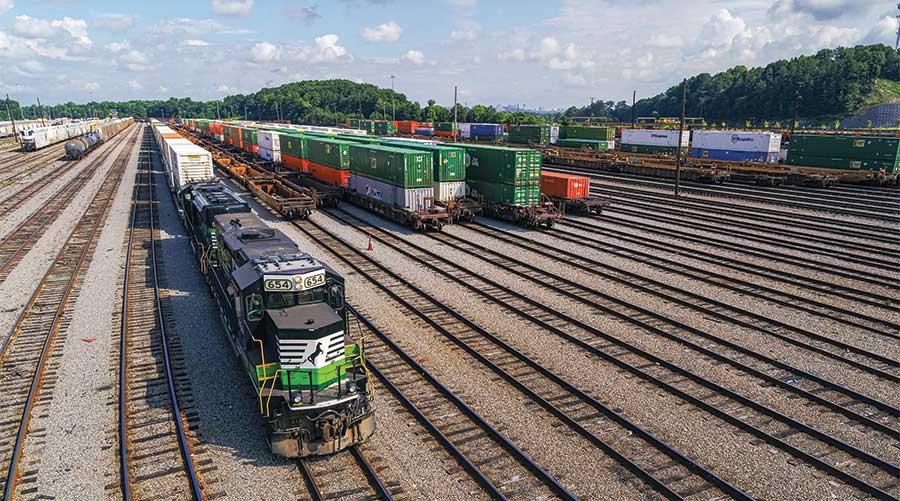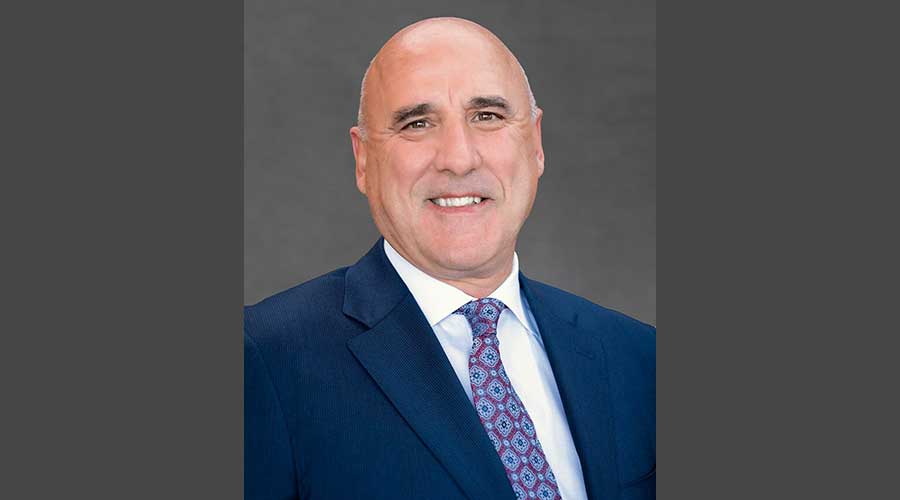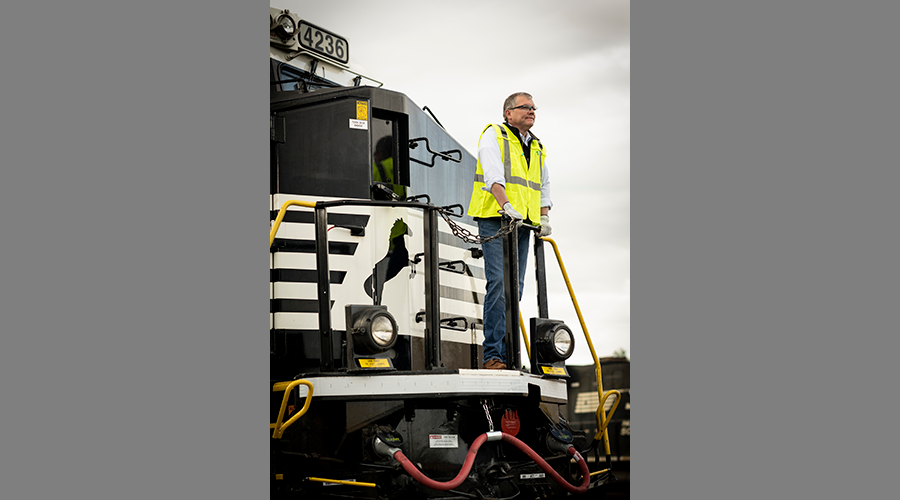Stay updated on news, articles and information for the rail industry
March 2022
Rail News: Shippers
Supply-chain changes prompt Norfolk Southern to alter its operating course, sharpen customer focus
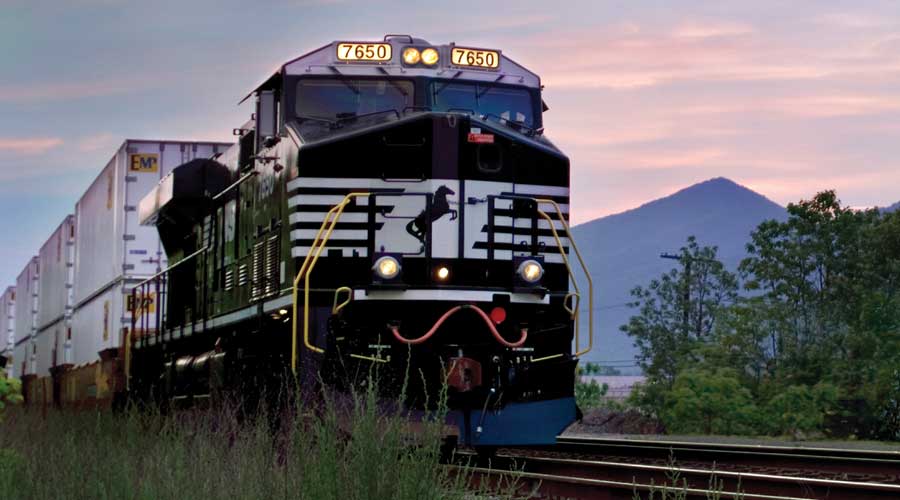
By Jeff Stagl, Managing Editor
Based on momentum gained with revenue generation, cost containment, productivity and efficiency, Norfolk Southern Railway’s near-term prospects are promising. After an anticipated strong first six months in 2022, high freight demand and significant service improvements are projected to drive robust operational and financial performance in the second half.
NS’ operating ratio (OR) this year likely will improve by 50 to 100 basis points — then continue to ratchet down — after the railroad set OR records in 2021 for a fourth quarter (60.4, down 1.4 points) and full year (60.1, down 4.3 points). Also, revenue is projected to grow by a single-digit percentage and dividends are expected to reach 35% to 40% of net income.
That’s the message NS leaders delivered Jan. 26 during the Class I’s fourth-quarter earnings conference, using various financial terms to characterize the Class I’s sunnier outlook after storm clouds rained down on the company’s performance the past several years. But there’s a more direct way to describe how NS has gone from inhibited growth to the promise of unconstrained prosperity: a change in direction has helped change the narrative.
After the pandemic struck, supply chains shifted, e-commerce exploded, a freight recession settled in and business as usual became business as highly unusual, NS leaders found the railroad wasn’t well prepared for such adversity. The operating plan wasn’t comprehensive enough, capacity wasn’t in place in all areas where it was critically needed, the railroad wasn’t as customer-focused as they’d thought, and resources weren’t well aligned or stocked. The outcome: mostly undesirable results.
For example, a workforce shortage last year caused by the tight labor market created acute operational challenges across several parts of the railroad’s network while some aspects of service — from train velocity to on-time deliveries — vastly underperformed.
So, NS leaders set a new course for the railroad, one that includes a new operating plan, a more customer-centric approach, and additional automation and resources. The new course already has helped the railroad do a better job of meeting service commitments and exploiting business opportunities, NS Chairman and CEO James Squires said during the earnings conference.
“We have met and exceeded our goals, albeit with a very different formula than originally anticipated given the … headwinds, demonstrating our ability to adapt and innovate, and our dedication to deliver,” said Squires, who will retire in May and be succeeded by NS President Alan Shaw.
The keys to maintaining and enhancing that dedication: drive more service improvements that meet the expectations of customers, push productivity and automation initiatives to help bolster performance, and broaden sustainability efforts, since many shippers strongly consider environmental stewardship when choosing a mode.
NS needs to make a compelling case that it’s a transportation provider of choice to take better advantage of its eastern network — where 60% of the U.S. population resides — powerful intermodal franchise and ongoing adaption to momentous marketplace changes, says NS Executive Vice President and Chief Marketing Officer Ed Elkins.
The global supply chain is under duress, causing greater variations in supply-chain risk and shifts to shorter chains. More manufacturing, distribution and warehousing investments pegged for overseas are being shifted to North America, with warehouses built near rail and desirable highways the first manifestation of that trend, Elkins says.
“You hear about re-shoring and near-shoring, but I call it ‘un-shoring,’” he says. “The supply chain is dislocated now and there are smart people who want to fix it, and they will fix it. We need to be prepared for after that [since] we are a link in the supply chain.”
Flexibility with freight
For NS, the “North Star” is the flexible freight market through which a transportation buyer has a choice of rail or truck, he says. To expand its role in that universe, NS last year launched Thoroughbred Freight Transfer (TFT), a hybrid service targeting less-than-truckload shipments.
Freight moves door to door in box cars on unit trains in the Atlanta, Chicago, Miami and Croxton, New Jersey, markets. TFT offers several flexible supply-chain options for shippers who consolidate products into a single source or deconsolidate products from rail to multimodal services.
“We want to be able to execute at the pallet level. It’s all about how we can add value with non-traditional rail customers,” says Elkins.
But to attract more customers for TFT and other offerings, it comes down to the quality of options and service performance NS offers. Although the Class I now is better positioned to provide value for customers, operational performance “isn’t quite there and needs fixing,” says Elkins.
“There are reasons for that. The labor shortage is everywhere, there aren’t enough truckers and trucks, warehouses are seeing problems with productivity, and ports are seeing same thing,” he says. “There are difficulties when links in the supply chain are challenged.”
Since every company seeks growth, NS needs to meet shippers’ needs so they can better serve their own customers, Elkins says.
Enter a significant effort to bolster service performance and, in turn, promote growth. NS late last year began to develop TOP|SPG, for which the first three letters stand for Thoroughbred operating plan, and the latter three stand for service, productivity and growth.
The next generation of the Class I’s precision scheduled railroading operating plan, TOP|SPG will be designed to take a data-driven, customer-centric approach to foster more collaborative performance, meaning field workers will be able to execute it daily. The plan includes train schedules and car blocking plans.
Start with a clean slate
TOP|SPG is being developed via a ground-up, clean-slate approach to remove historical constraints and take a fresh look at operating needs. Lessons learned the past three years from current operating plan TOP21 — such as the need for more operational balance — will be leveraged.
The new plan will be implemented in phases, with a rollout expected to begin in the second quarter and continue through the rest of the year. TOP21 mostly focused on the merchandise network, but TOP|SPG will be a more comprehensive plan that also incorporates the intermodal, auto and unit train networks.
“Customers demand predictable and reliable service so they can plan their supply chains. No one wants to do business with an inefficient partner,” says Elkins. “You need to have a platform for growth, and that’s TOP|SPG. We can unlock a lot of value because we can move longer and heavier trains with more balance.”
TOP|SPG will help increase the capacity of trains, improve transit times and build off service performance as the plan is executed, says NS VP of Network Planning and Optimization John Friedmann.
“The world has shifted since TOP21 was implemented. TOP|SPG is a balanced plan,” he says. “We see it as a plan for growth.”
The challenge during the plan’s development is preparing workers to embrace something different, says Friedmann, who retired March 1. NS last month appointed Paul Duncan — most recently BNSF Railway Co.’s VP of service design and performance — VP of network planning and operations to succeed Friedmann.
Some employees still tend to resist change.
“We are trying to develop TOP|SPG with zero constraint, meaning to come up with the best plan without constraining ourselves as we’ve done in the past,” says Friedmann.
The might of a new site
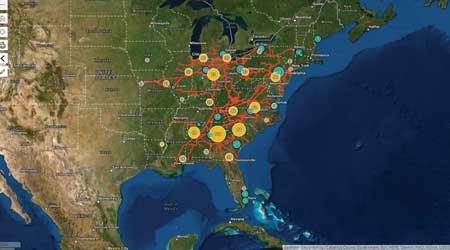
A few constraints also have been a factor in attracting industrial development (ID) projects along NS’ lines — an important aspect of driving volume growth. A major impediment was addressed in late 2021 when the railroad launched NSites, a GIS-based search engine tool designed to help businesses more easily find rail-served industrial sites and transload facilities.
The online portal provides comprehensive information about industrial sites near NS’ transportation infrastructure. It targets manufacturers, distributors, site selection professionals, supply chain managers and others involved in industrial projects.
NSites currently includes more than 800 available industrial locations across the railroad’s 22-state territory verified as rail accessible by NS or one of its short-line partners, and 250 transload facilities in the eastern United States.
“We have had this information on rail-served sites for a long time, but we kept it to ourselves and didn’t make it publicly available,” says NS Group Manager of Technical Services Ryan Hegarty. “Two years ago, we came up with this idea to show customers a way to do business with us.”
The site’s developers first worked on gathering and refining the data to ensure all information is sortable and accessible.
Similar to online travel planning and residential real estate sites that enable users to perform searches based on their own criteria, NSites provides customizable property searches via targeted filters. Searchers can sift through results based on acreage, location, existing warehousing, and proximity to highways, intermodal terminals and port facilities.
“We call it Zillow for railroads,” says Hegarty. “We wanted it to be first in class and have the feel of real estate and travel sites people are used to, but be customized with filters.”
The tool can be used to identify and compare desired rail-served industrial sites — an important attribute since the pandemic has pushed many manufacturers to redesign their supply chains in favor of locating inventories closer to customers.
“They can get the information quickly that might have taken two weeks to get by using various websites and making phone calls,” says Hegarty.
Building interest
Gathering and disseminating vital information quickly to potential customers continues to be key to driving ID. NS’ ID team tries to promote valuable properties in the railroad’s 22-state network.
The team offers technical services to provide free pre-engineering plans to interested parties. The plans include a view of a project with the associated rail infrastructure in mind, says NS VP of Business Development and Real Estate Kathleen Smith.
“Our expertise comes into play. We align efforts with our commercial groups to work hand in hand,” she says.
NS currently has an active pipeline of ID projects, with some involving an industry investment greater than $1 billion. The projects cover various markets, including steel, automotive, cold storage and manufacturing to support U.S. consumers’ demand for durable goods.
“We benefit from hard-core manufacturing projects,” says Smith, adding there’s also notable activity with projects involving electric vehicle and battery production facilities, sustainable steel mills, auto plants and cold storage facilities.
Over the past year-plus, the team has helped attract the following projects along NS-served lines:
• a Red Bull and Rauch facility in Concord, North Carolina, set to start operations in the third quarter;
• an E. & J. Gallo Winery production and distribution facility in Chester, South Carolina, expected to open its first phase by 2022’s end;
• an International Paper facility in Atglen, Pennsylvania, slotted to begin producing cardboard in first-quarter 2023;
• Sherwin-Williams Co. manufacturing and distribution facilities in Statesville, North Carolina, pegged to open by 2024’s end; and
• a Toyota battery plant in Greensboro, North Carolina, projected to start up in 2025.
In addition, Package Corp. of America is converting its paper mill in Jackson, Alabama, to produce brown instead of white paper to accommodate the growing demand for boxes generated by online shopping. To be completed in about three years, the project includes an on-site track expansion to accommodate a projected growth in rail volume, says Smith.
A recently completed ID project that’s paying off in carloads is an auto assembly plant in Huntsville, Alabama, that began producing the Toyota Corolla Cross and Mazda CX-50 vehicles in fall 2021. The first rail shipments started in October.
“Our strong relationship with the state of Alabama was key,” says Smith. “The state has been very successful in landing projects.”
A corridor connection
NS’ ties to Alabama led to the recent unveiling of the A-USA Corridor in January. The corridor involves a $71.6 million initiative to link the Port of Mobile with NS’ McCalla Intermodal Facility near Birmingham. The 280-mile rail corridor will also link mega economic development sites in Etowah, Shelby and Washington/Mobile counties, each totaling more than 1,000 acres.
“There has been a depletion of available sites in the state. If we want to grow, we need a replenishment of mega sites,” says Smith.
The railroad has proposed a $231.6 million program of projects to upgrade infrastructure in central and southern Alabama. The first phase of work involves 12 track, signal and yard improvement projects between Mobile, Selma and Birmingham.
“We did an assessment of projects needed and came up with a list that’s the right mix,” says Smith. ‘We’re not sure when work will start. It will be a multiyear program of projects.”
The state has applied for a federal Consolidated Rail Infrastructure and Safety Improvements Program grant for the A-USA corridor. Alabama officials expect to hear back about the grant application in spring.
In the meantime, the NS industrial development team plans to continue emphasizing the railroad’s sustainability efforts to attract more projects. Many customers and investors believe sustainability holds value when making business decisions, says NS Chief Sustainability Officer Josh Raglin.
“I spend a quarter of my time talking about sustainability with customers. We are seeing supply chain engagement on it,” he says. “Some customers want to move more freight on rail than on truck, which makes us try to think more truck-like.”
A prime example of an NS growth initiative that involves sustainability is RailPulse, Raglin says. Created in 2020 by NS, GATX Corp., Genesee & Wyoming Inc., TrinityRail and Watco, RailPulse aims to facilitate and accelerate the adoption of telematics across the North American rail-car fleet.
Fleet data will be aggregated on a single platform to increase safety and efficiency, and enhance the visibility of goods throughout the shipping process. RailPulse will offer real-time performance information and safety data to shippers, car owners and railroads. The information will include the status, location and condition of rail equipment and commodities carried.
Collectively, RailPulse partners — which also now include Greenbrier Cos. Inc. — own more than one-quarter of the North American car fleet. The platform is under design by Princeton Consultants Inc. and is expected to roll out in first-quarter 2023 after a pilot is carried out through 2022.
In terms of sustainability, RailPulse will tap into car sensors to help ensure hazardous materials aren’t dropped along NS’ lines. In addition, physical requirements necessary for car installations, safety and environmental concerns will be defined.
Dual purpose
In part to advance its own sustainability goals, NS has also rolled out a pilot incentive program for intermodal shipping partners. Introduced late last year, the dual mission reward program aims to drive market efficiencies and grow capacity at the Class I’s international intermodal terminals.
The program is being tested at NS’ Landers intermodal facility in Chicago — its largest international freight terminal — and an intermodal facility in Kansas City, Missouri. Under the pilot, truck carriers and steamship lines can earn a $200 incentive every time a drayage driver brings in and departs with a container, preventing “empty” trips.
The program can help unclog pandemic-related bottlenecks across the transportation supply chain as well as generate significant sustainability benefits, says Raglin. At Landers, NS estimates the program has the potential to eliminate about 46,000 truck trips, reduce fuel usage by 546,000 gallons and reduce carbon emission by over 5,600 metric tons annually if truckers complete a “dual mission” at least half the time.
“We are looking at saving emissions from empty truck miles. We have not coordinated efforts well with ocean carriers about having loads picked up at our terminals,” says Raglin.
Other recent sustainability efforts include pursuing more renewable energy projects, such as to power certain operations; analyzing the use of hybrid switchers that use less fuel and produce less noise; piloting road locomotives powered by low-carbon and alternative fuels; and adopting diesel-electric hybrid overhead gantry cranes at several intermodal terminals.
In addition, NS in December 2021 teamed up with U.S. Steel Corp. and Greenbrier to announce an order for 800 sustainable steel gondola cars. To be engineered by Greenbrier, the cars will feature a high-strength, lighter-weight steel developed by U.S. Steel that will reduce each car’s unloaded weight by up to 15,000 pounds. NS will use the cars to transport loose bulk materials such as metal scraps, coils, wood chips, steel slabs and ore.
The new gondola will be more energy efficient since the steel fabrication process will require less and less material. Plus, the car’s lower weight decreases the amount of fuel used by locomotives to haul it.
“We will look to do this in other areas of our rail-car fleet,” says Raglin. “We also are looking at aerodynamics more, such as how we build trains, like intermodal trains, and where the open spaces are. We want to gain more fuel efficiency at the train level.”
The rail industry is trying to forge sustainability into a cultural change, similar to what was done with safety. And it took decades for railroads to develop a safety culture, says Raglin. Efforts to instill environmental stewardship shouldn’t take nearly as long, but likewise promise a big payoff.
“Sustainability provides business opportunities,” says Raglin.
And as the U.S. economy continues to grow, those opportunities abound today.
“Last year, for the first time in my 32 years, the industry ran out of trucks. It was a remarkable phenomenon,” says EVP and CMO Elkins. “There is a lot of unmet need.”
He is optimistic NS is on the right path to becoming a better need fulfiller.
“We have a noble mission to serve the U.S. economy,” says Elkins.
Email questions or comments to jeff.stagl@tradepress.com.


 2025 MOW Spending Report: Passenger-rail programs
2025 MOW Spending Report: Passenger-rail programs
 Gardner steps down as Amtrak CEO
Gardner steps down as Amtrak CEO
 Guest comment: Oliver Wyman’s David Hunt
Guest comment: Oliver Wyman’s David Hunt
 Women of Influence in Rail eBook
Women of Influence in Rail eBook
 railPrime
railPrime




